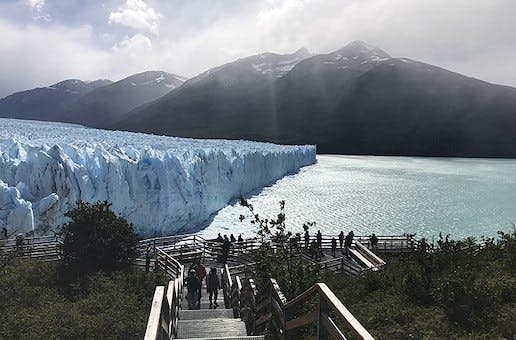Communist China Is Threatening One of Argentina’s Most Important Landmarks
The construction of two dams as part of the Belt and Road Initiative is seen as harmful to important glaciers and to the biodiversity of a large region.

Communist China is threatening one of Argentina’s most popular tourism attractions by building two dams on the Santa Cruz river, in the province of Santa Cruz, threatening glaciers and the area’s general biodiversity.
One of the biggest energy projects in Argentina, the hydroelectric complex is projected to supply about 5 percent of the country’s energy demands — at a huge cost to the surrounding areas. Environmental organizations say the dams will flood vital wetlands and ancestral indigenous lands and alter the trajectories of the world’s largest glaciers outside the poles.
The Perito Moreno glacier was declared a World Heritage Site by Unesco in 1981. El Calafate, the nearest city, is the second most visited destination in Argentina, after Buenos Aires, according to the tourism secretary.
Construction of the Néstor Kirchner and Jorge Cepernic dams, named after two leftist Argentine politicians, started in 2015; one is expected to start functioning in 2024 and the other is slated for 2027. The project has sparked protests and court orders. Ecological organizations have sent letters to Communist China’s Ministry of Commerce but never received a response, according to the Environment and Natural Resources Foundation of Argentina.
“Authorities are aware of the laws and know how they work,” a member of the Forest for the Sustainable Management of Natural Resources Foundation, Cristian Fernandez, told the news organization Mongabay. “The problem is that they don’t care. They want to move forward with the project at all costs.”
The construction of the dams is part of the Chinese Belt and Road Initiative, a Communist Chinese scheme to reinforce relations with more than 140 countries through the development of infrastructure. The project is being built by the Temporary Union of Patagonia Dam Companies, an organization composed of a Communist Chinese company, Gezhouba Group, and an Argentinian company, Hidrocuyo S.A. It receives financing from several Chinese banks.
The Santa Cruz river, on which the dams are being built, is the largest waterway in the southern part of the country. It starts in the Andes and flows into the Atlantic Ocean.
The dams will affect the melting rates of three glaciers, according to the Institute of Glaciology and Environmental Sciences of Argentina. The dams are expected to flood about thirty-five thousand hectares of the area.
The administration of National Parks is concerned about the long-term effects of the dams; the flooding would permanently affect the flora and the bird families that live around the Santa Cruz river.
The administration warned last year that the dam construction plan lacked sufficient specifics and included inaccuracies, including regarding bird migration patterns and an accounting of the exotic fish in the area. According to the Institute of Glaciology and Environmental Sciences of Argentina, the studies referenced were from 1996.
The National Institute for Seismic Prevention presented similar conclusions, saying that the plan’s geological and seismic data were “questionable” and that analysis of the ground around the dam was never included in the original studies.
“I hope that the Supreme Court handles this case and stops the construction of the dams,” Mr. Fernandez said. “It’s about more than just the violation of many environmental laws. It’s about the damage affecting biodiversity and glaciers.”

